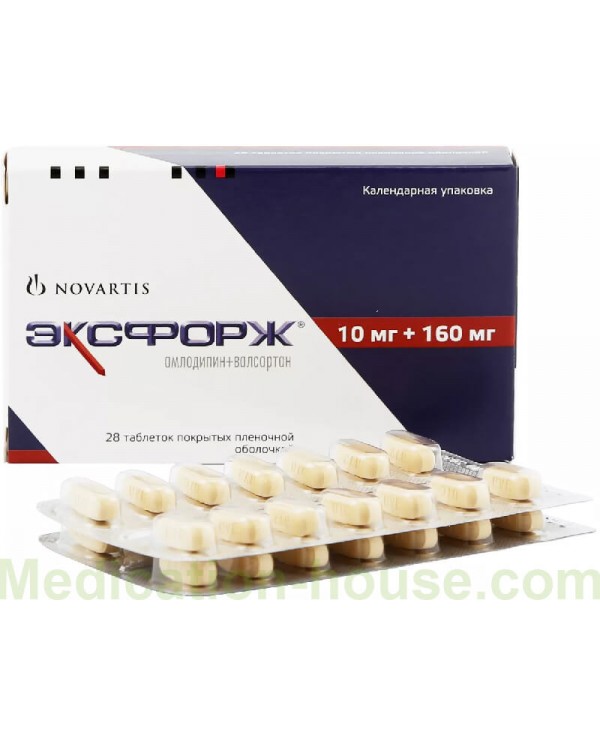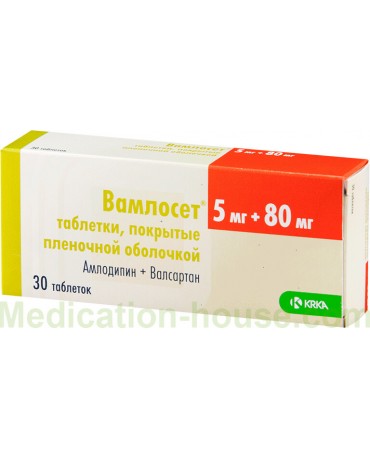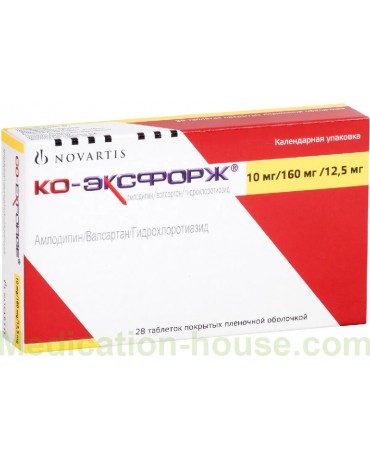Instruction for Exforge
Reed more and buy Exforge on this page
Exforge is a combined antihypertensive drug.
Release form and composition
Exforge is available in the form of film-coated tablets: with beveled edges, the inscription "NVR" on one side, in three doses: 5 mg / 80 mg - dark yellow, round, with the inscription "NV" on the other side; 5 mg / 160 mg - dark yellow, oval, with the inscription on the other side "ECE"; 10 mg / 160 mg - light yellow, oval, with the inscription on the other side "UIC" (in blisters: 7 pcs., In a cardboard box 1, 2, 4, 8, 14 or 40 blisters; 10 pcs. , in a cardboard box 3, 9 or 28 blisters; 14 pcs., in a cardboard box 1, 2, 4, 7 or 20 blisters).
1 tablet contains:
active ingredients (5 mg / 80 mg, 5 mg / 160 mg, 10 mg / 160 mg): amlodipine besylate - 6.94 mg, 6.94 mg, 13.87 mg (equivalent to 5 mg, 5 mg, 10 mg amlodipine respectively), valsartan - 80 mg, 160 mg, 160 mg, respectively;
excipients: crospovidone, microcrystalline cellulose, colloidal silicon dioxide, magnesium stearate;
composition of the film shell: Premix white (titanium dioxide, hypromellose, talc, polyethylene glycol 4000), Premix yellow (iron oxide yellow, hypromellose, talc, polyethylene glycol 4000), purified water.
In addition, Premix red (iron oxide red, hypromellose, talc, polyethylene glycol) is additionally coated with tablets at a dose of 10 mg / 160 mg.
Pharmacodynamics
Exforge is a combined preparation consisting of two active substances - amlodipine and valsartan, which have antihypertensive properties. Their action complements each other in the control of blood pressure (BP) and contributes to a more pronounced decrease in it than with monotherapy with each of them separately.
Amlodipine - a blocker of slow calcium channels, a derivative of dihydropyridine, inhibits calcium ions during transmembrane entry into vascular smooth muscle cells and cardiomyocytes. The mechanism of action of amlodipine is aimed at direct relaxation of vascular smooth muscles, which causes a decrease in the total peripheral vascular resistance and a decrease in blood pressure.
Reception of therapeutic doses for arterial hypertension causes vasodilation and a decrease in blood pressure in a patient lying or standing. Against the background of prolonged use, there is no significant change in the heart rate (HR) and the level of catecholamines with a decrease in blood pressure.
Plasma concentration levels correlate with therapeutic effect regardless of the patient's age.
With normal renal function, therapeutic doses of amlodipine cause a decrease in renal vascular resistance. Promote an increase in the rate of effective renal blood flow and glomerular filtration without changing the level of proteinuria and filtration fraction.
The use of amlodipine in patients with normal function of the left ventricle causes a slight increase in its volume, cardiac index without a significant effect on the maximum rate of pressure increase in the left ventricle, end diastolic blood pressure.
Therapeutic doses of amlodipine are not accompanied by a negative inotropic effect, including when combined with beta-blockers.
With arterial hypertension or angina pectoris, the simultaneous use of amlodipine and beta-blockers is not accompanied by pathological changes in the parameters of electrocardiography (ECG).
The effectiveness of amlodipine has been proven in the treatment of chronic stable angina pectoris, vasospastic angina pectoris, angiographically confirmed coronary artery disease.
Valsartan is a specific and active antagonist of angiotensin II receptors. Intended for oral administration, it has a selective effect on receptors of the AT1 subtype. An increase in the concentration of free angiotensin II in blood plasma as a result of blockade of AT1 receptors by valsartan can stimulate unblocked AT2 receptors and counteract the effects of AT1 receptor blockade. Valsartan does not have a pronounced agonist activity against AT1 receptors. The affinity of valsartan to the AT1 subtype receptors is approximately 20,000 times higher than to the AT2 subtype receptors.
Valsartan does not inhibit angiotensin-converting enzyme (ACE), which converts angiotensin I to angiotensin II and promotes the destruction of bradykinin.
The use of valsartan practically does not cause the development of dry cough.
It does not interact with or block ion channels or hormone receptors, which play an important role in the regulation of the functions of the cardiovascular system.
By lowering blood pressure, valsartan has no effect on heart rate.
After taking a single dose of the drug, the therapeutic effect is manifested within 2 hours, the maximum decrease in blood pressure develops in 4-6 hours. The antihypertensive effect lasts more than 24 hours. A sustained maximum decrease in blood pressure is usually achieved after 14–28 days of using the drug, regardless of the dose, and is supported by long-term therapy.
Abrupt withdrawal of valsartan does not cause a sharp increase in blood pressure or other undesirable clinical consequences. Taking the drug for chronic heart failure of the II-IV class according to the classification of NYHA (New York Heart Association) leads to a significant decrease in the number of hospitalizations among patients. This is more common in patients who are not receiving beta-blockers or ACE inhibitors. Taking valsartan reduces cardiovascular mortality among patients with a stable clinical course of left ventricular failure or with impaired left ventricular function after myocardial infarction.
The antihypertensive effect when taking Exforge 1 time per day lasts for 24 hours.
With an initial systolic blood pressure of 153-157 mm Hg and a diastolic blood pressure below 95-110 mm Hg, tablets at doses of 5 mg / 80 mg and 5 mg / 160 mg reduce blood pressure by 20-28 / 14-19 mm Hg (in comparison with placebo values of 7-13 / 7-9 mm Hg, respectively).
At a dose of 10 mg / 160 mg and 5 mg / 160 mg tablets normalize blood pressure (diastolic blood pressure in the sitting position becomes below 90 mm Hg) in 75 and 62% of patients with inadequate blood pressure control while taking valsartan at a dose of 160 mg per day as a monopreparation.
In patients in whom monotherapy with amlodipine or valsartan was ineffective, the drug can normalize and control blood pressure.
The therapeutic effect of the drug does not depend on the patient's sex, age, race and lasts for 1 year. The sudden cancellation of Exforge is not accompanied by a sharp increase in blood pressure.
The use of the drug reduces the likelihood of developing edema.
Pharmacokinetics
The pharmacokinetics of amlodipine and valsartan are linear.
After oral administration of a therapeutic dose of amlodipine, the maximum concentration (Cmax) in blood plasma is reached after 6-12 hours. The absolute bioavailability of amlodipine is 64–80%. Food intake does not affect its bioavailability.
Plasma protein binding - 97.5%.
Approximately 90% of amlodipine is metabolized in the liver to form active metabolites.
T1 / 2 (half-life) of amlodipine - 30-50 hours.
The equilibrium level of concentration in blood plasma occurs after 168-192 hours of therapy. It is excreted through the kidneys: 10% - unchanged, 60% - in the form of amlodipine metabolites.
After oral administration of a therapeutic dose of valsartan, Cmax in blood plasma is reached after 2-3 hours. Its absolute bioavailability is 23%. With food intake, its bioavailability decreases by almost 40%, but since this has no clinical significance, the tablets can be taken regardless of food intake.
Plasma protein binding - 94–97%, mostly with albumin.
Only about 20% of the accepted dose of valsartan is determined in the form of metabolites. Less than 10% of the total plasma concentration is determined as a pharmacologically active hydroxyl metabolite.
T1 / 2 valsartan - 6 hours.
About 83% of the dose is excreted through the intestines in unchanged form and about 13% of the dose through the kidneys.
Cmax of amlodipine in blood plasma in young and elderly patients occurs after the same period of time.
The clearance of amlodipine in elderly patients is slightly reduced, which causes an increase in T1 / 2.
For elderly and younger patients, it is recommended to use the usual dosing regimens of valsartan.
In case of impaired renal function with creatinine clearance (CC) of 30-50 ml / min, a change in the initial dose of the drug is not required.
In patients with hepatic insufficiency, the clearance of amlodipine is reduced, which leads to an increase in the total concentration of amlodipine in the blood plasma by about 40-60%. With a mild to moderate degree of chronic liver disease, the bioavailability of valsartan increases.
Indications for use
According to the instructions, Exforge is indicated for the treatment of hypertension in patients who can use combination therapy.
Contraindications
unilateral or bilateral stenosis of the renal arteries, stenosis of the artery of a single kidney;
period of pregnancy;
breast-feeding;
age under 18;
hypersensitivity to the components of the drug.
Care should be taken when prescribing Exforge to patients with mitral stenosis, aortic stenosis, hypertrophic obstructive cardiomyopathy, liver pathology (especially with obstructive biliary tract diseases), severe renal impairment (CC less than 10 ml / min), hyperkalemia, sodium deficiency, with reduced volume circulating blood.
Instructions for the use of Exforge: method and dosage
Exforge tablets are taken orally, regardless of food intake, with a sufficient amount of water, 1 time per day.
Recommended dosage: 1 pc. at a dose of 5 mg / 80 mg, 5 mg / 160 mg or 10 mg / 160 mg.
The maximum daily dose is 10 mg / 160 mg.
Changes in the dosage regimen when prescribing Exforge to patients with mild or moderate renal impairment (CC greater than 30 ml / min), liver disease, impaired liver function, with symptoms of cholestasis or elderly patients is not required.
Side effects
on the part of the cardiovascular system: sometimes - orthostatic hypotension, tachycardia, palpitations; rarely - a pronounced decrease in blood pressure, syncope;
from the respiratory system: often - flu, nasopharyngitis; sometimes - cough, pain in the pharynx and / or larynx;
from the nervous system: often - headache; sometimes - drowsiness, paresthesia, dizziness, orthostatic dizziness;
from the immune system: rarely - hypersensitivity;
mental disorders: rarely - anxiety;
from the senses: rarely - tinnitus, visual impairment; sometimes - dysfunction of the vestibular apparatus, causing dizziness;
from the digestive system: sometimes - dry mouth, nausea, abdominal pain, diarrhea, constipation;
dermatological reactions: sometimes - erythema, skin rash; rarely - itching, hyperhidrosis, exanthema;
from the genitourinary system: rarely - polyuria, pollakiuria, erectile dysfunction;
from the musculoskeletal system: sometimes - joint swelling, arthralgia, back pain; rarely - muscle spasms, a feeling of heaviness throughout the body;
laboratory parameters: increased blood urea nitrogen;
others: often - increased fatigue, facial edema, pastiness, peripheral edema, flushing of the face, fever, asthenia.
In addition, against the background of the use of Exforge, it is possible to develop undesirable phenomena that are characteristic of monotherapy with each of the active substances of the drug.
The most common side effect of amlodipine is nausea. Less commonly, there is general malaise, dry mouth, dyspepsia, changes in the frequency of bowel movements, alopecia, gingival hyperplasia, shortness of breath, rhinitis, gastritis, hyperglycemia, gynecomastia, increased urination, erectile dysfunction, leukopenia, mood lability, peripheral neuropathy, myaltopenia erythema multiforme, angioedema, pancreatitis, hepatitis, increased sweating. When using amlodipine in patients with heart failure (grade III – IV according to the NYHA classification) of non-ischemic etiology, an increase in the incidence of pulmonary edema was noted. In rare cases, against the background of the use of blockers of slow calcium channels, especially in severe coronary heart disease, it is possible to develop acute myocardial infarction or increase the frequency, duration and severity of angina pectoris, the development of arrhythmias (including atrial fibrillation and ventricular tachycardia).
When using valsartan as monotherapy, such undesirable effects as sinusitis, viral infections and upper respiratory tract infections, rhinitis, insomnia, neutropenia, a significant increase in the level of creatinine and urea nitrogen in the blood were noted. An increase in the level of potassium concentration in the blood serum is possible.
Overdose
Symptoms: typical for an overdose of valsartan - the development of a pronounced decrease in blood pressure, dizziness, amlodipine - excessive peripheral vasodilation, reflex tachycardia. The occurrence of prolonged and severe systemic arterial hypotension with the development of shock with a fatal outcome is possible.
Treatment: if you accidentally take a high dose of Exforge, you should immediately induce vomiting or make a gastric lavage. Activated charcoal significantly reduces the absorption of amlodipine taken over the next two hours.
With severe arterial hypotension, the patient should be laid down with raised legs. The clinic is aimed at maintaining the activity of the cardiovascular system, it requires regular monitoring of the function of the heart, respiratory system, circulating blood volume, and the amount of urine excreted. To restore blood pressure and vascular tone, it is possible to use a vasoconstrictor. To eliminate the blockade of calcium channels, intravenous administration of calcium gluconate is indicated.
Hemodialysis for the elimination of valsartan and amlodipine is ineffective.
Special instructions
Before starting therapy with Exforge, previously taken beta-blockers, if necessary, should be canceled by gradually lowering the dose in order to avoid the development of a withdrawal syndrome.
The prescription of the drug is recommended on the basis of laboratory parameters of the sodium content in the body and the volume of circulating blood (BCC), since their deficiency can cause severe arterial hypotension. With a deficiency of BCC and / or sodium, it is necessary to correct them and begin treatment under the close supervision of a physician. With the development of arterial hypotension, the patient should take a horizontal position with raised legs. The introduction of saline is shown. When the blood pressure stabilizes, you can continue taking Exforge.
Influence on the ability to drive vehicles and complex mechanisms
Since dizziness, increased fatigue, drowsiness may occur while taking Exforge, patients are advised to be careful when driving or working with complex mechanisms.
Application during pregnancy and lactation
The use of Exforge is contraindicated during gestation and breastfeeding.
The drug affects the RAAS (renin-angiotensin-aldosterone system), therefore, its use during pregnancy can cause spontaneous abortion, development of fetal pathology, impaired renal function and oligohydramnios in newborns.
Patients of childbearing age should be informed about the effect of the drug on the RAAS and the possible threat to the normal development of the fetus if they wish to become pregnant in the future.
If pregnancy occurs while taking Exforge, therapy should be discontinued immediately.
Childhood use
The use of Exforge for the treatment of children under the age of 18 is not recommended due to the lack of safety data.
With impaired renal function
Exforge should be used with caution in severe renal impairment (CC less than 10 ml / min).
Changes in the dosage regimen with mild or moderate renal dysfunction (CC more than 30 ml / min) is not required.
For violations of liver function
The drug should be used with caution in patients with impaired liver function, especially in obstructive diseases of the biliary tract.
Changes in the dosage regimen when prescribing Exforge to patients with liver diseases, impaired liver function, with symptoms of cholestasis is not required.
Use in the elderly
Correction of the dosage regimen for elderly patients is not required.
Drug interactions
When monotherapy with each of Exforge's active substances, there is no clinically significant interaction with the following drugs:
amlodipine: beta-blockers, thiazide diuretics, ACE inhibitors, nitroglycerin for sublingual use, long-acting nitrates, atorvastatin, digoxin, warfarin, sildenafil, cimetidine, maalox (aluminum hydroxide gel, magnesium hydroxide, symethydoglycemic drugs), non-percutaneous drugs anti-inflammatory drugs;
valsartan: amlodipine, cimetidine, furosemide, warfarin, digoxin, atenolol, indomethacin, glibenclamide, hydrochlorothiazide.
It is recommended to be careful and carry out frequent monitoring of the concentration of potassium in the blood while using the drug with heparin, potassium-sparing diuretics, dietary supplements containing potassium, potassium-containing salt substitutes and other agents that can cause an increase in the level of potassium in the blood.
Terms and conditions of storage
Keep out of the reach of children.
Store at temperatures up to 25 ° C, protected from moisture.
Shelf life is 2 years.
Reviews
Reviews about Exforge are mixed. Patients with positive reviews indicate the effectiveness and good tolerance of the drug over several years of use. Some patients note its unjustifiably high cost, offering to replace it with an affordable and effective analogue of domestic production.
There are reports of the development of adverse events while taking Exforge.
Terms of sell
You don't need to have a prescription from a doctor to buy Exforge.



